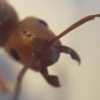Nah, looks like one of the claustral Aphaenogaster. Too far away to get a good ID on it, though.
A. tennesseensis queens are around 5mm and a bit shinier. To be sure, if you look under the wings, you would be able to see some wickedly large propodeal spines.
If you've enjoyed using my expertise and identifications, please do not create undue ecological risk by releasing your ants. The environment which we keep our pet insects is alien and oftentimes unsanitary, so ensure that wild populations stay safe by giving your ants the best care you can manage for the rest of their lives, as we must do with any other pet.
Exotic ants are for those who think that vibrant diversity is something you need to pay money to see. It is illegal to transport live ants across state lines.
----
Black lives still matter.


















